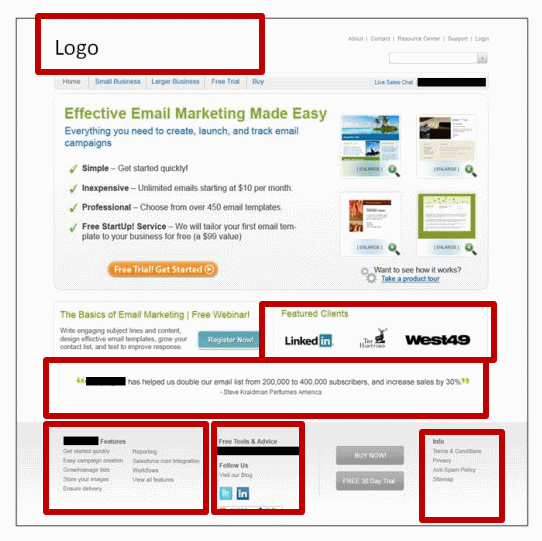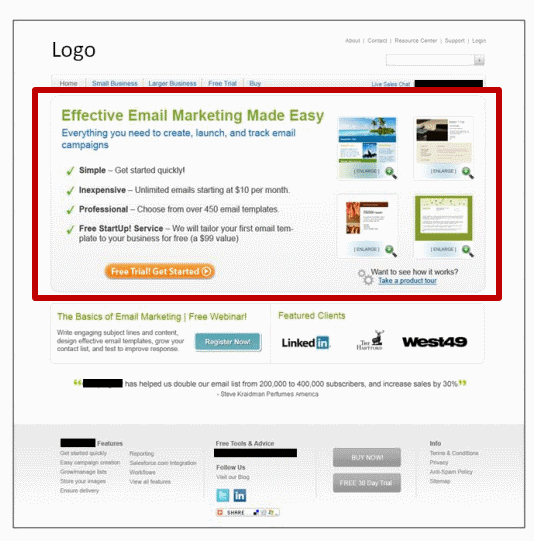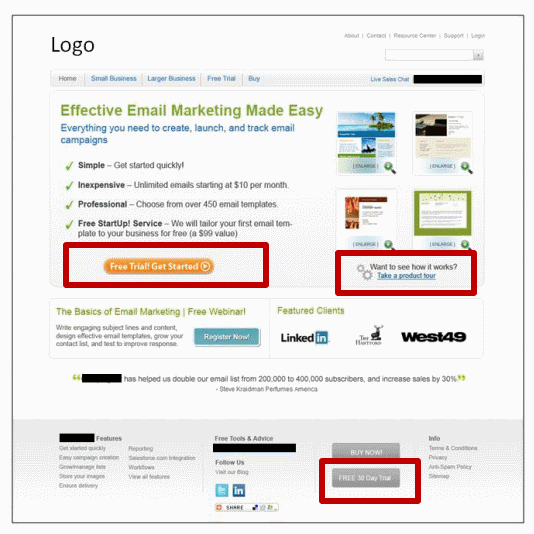When you break marketing down, strip away marketing automation platforms and analytics and clickthrough rates, marketing is essentially communicating value to the customer in the most efficient and effective way possible so they will want to take an action.
Of course, thanks to all the other complexities of daily life in the marketing department that I just mentioned, and many more, it’s easy to lose sight of this simple fact.
To communicate value, you need everyone who works on your marketing campaigns to have a clear understanding of your value proposition – not just for your company as a whole, but for every action you desire a customer to take.
Answering the question before you make the ask
“We need a way to identify and craft value propositions more specific to our current marketing efforts,” said Dr. Flint McGlaughlin, Managing Director and CEO, MECLABS. “Underneath all value propositions is an even more fundamental question.”
The fundamental question is: “If I am [a particular prospect] why should I [take this action] rather than [this/these other action(s)]?”
“Understanding this fundamental question gives us the flexibility to modify and create more specific ‘Derivative Value Propositions’ at four essential levels,” Flint said.
To aid you in crafting effective marketing, MECLABS has created The Value Proposition Spectrum to help you identify the questions that you need to answer at each level of your marketing efforts.
1. Primary Value Proposition
Your company needs a primary value proposition, which is the answer to the question: “Why should your ideal prospect buy from you rather than any of your competitors?”
But many marketers stop there. However, every action you ask every type of customer to take requires a value proposition. Whether you’ve taken the time to state it explicitly or not, your potential customers subconsciously (and sometimes consciously) ask themselves the value (for them specifically) of taking any action you ask them to take.
Here is an example of an anonymized page where the expressions of the company-level, primary value proposition are highlighted:

2. Prospect-Level Value Proposition
The best way to use this visual is from the inside out. As I said, start with the primary value proposition (which depending on your role within the organization, you may or may not have a hand in crafting), and then break out which key prospects you are targeting with your marketing.
For each prospect, you should answer this question: “Why should [PROSPECT A] buy from you rather than any of your competitors?”

3. Product-Level Value Proposition
Now that you’ve identified your prospects, which products are you trying to sell them? Each product requires its own value proposition, which you can craft by answering this question: “Why should [PROSPECT A] buy this product rather than any other product?”

4. Process-Level Value Proposition
As I said above, every action you ask a prospect to take requires a value proposition.
Now that you’ve identified a value proposition for each product you’re trying to sell each prospect that aligns with your company’s primary value proposition, you have to craft a value proposition for each conversion step associated with a specific product.
Here is an example question to ask yourself to help identify this process-level value proposition: “Why should [PROSPECT A] click this PPC ad rather than any other PPC ad?”
You need to answer the same question for an email capture page of, in the case of the example below, a webinar registration …

Related Resources:
Value Proposition: The driving force behind successful campaigns
Value Proposition: A free worksheet to help you win arguments in any meeting
How to Test Your Value Proposition Using a PPC Ad
Value Proposition: Revealing hidden value in your products and offers
Learn more about MECLABS methodology




Dear Daniel:
Thanks for this concise blog post.
I have to ask one thing though: How do luxury companies, such as fashion designers or high end autos convey their value proposition when similar objects by different merchants cost far less?
For example, how does a company like Abercrombie and Fitch get people to pay MORE for their shirts or sweaters when people could buy the same thing (sans the lettering / brand) for a LOT less at different big box department stores. I don’t think that a shirt by A&F has any features that would typically be valued more than a shirt by any other brand, would they?
I guess the question is; how do high-end companies use brand instead of a value proposition to get people to pay more for their goods?
Thanks in advance.
Thanks for the question, Just Jay.
I discuss fighting the low-cost leaders in this blog post — Consumer Marketing: All that stands between you and Walmart is a good story
When you say “people buy the same thing,” I would argue that they don’t. Yes, to me and you those shirts are the same. However, to the ideal customer for Abercrombie, they have an additional value worth paying for. And that is why it’s important to focus on your “ideal prospect,” not just a random customer. If you are in business, you should be able to serve a certain ideal prospect better than anyone, but likely won’t be able to serve every possible customer better than every other competitor.
I think Jim Collins discusses this same concept well when he says, “To be great, a company also has to make a distinctive impact. I define that by a test: If your company disappeared, would it leave a gaping hole that could not easily be filled by any other enterprise on the planet?”
I’m not familiar enough with Abercrombie to be able to definitively state their value proposition, but based on other luxury brands, I’m guessing the fact that fashion-conscious teenagers can buy clothes in their store and be less likely to be ostracized for not being “hip” or “with it” is part of the value they offer, a value that makes them more valuable to their ideal prospect than the “same thing” you or I could buy for much cheaper.
Thank you so much, Daniel, for the response.
And thank you for the link to your other post about Degree33 Surfboards.
You stated:
“However, to the ideal customer for Abercrombie, they have an additional value worth paying for.”
and you also mentioned:
“I’m guessing the fact that fashion-conscious teenagers can buy clothes in their store and be less likely to be ostracized for not being “hip” or “with it” is part of the value they offer, a value that makes them more valuable to their ideal prospect than the “same thing” you or I could buy for much cheaper.”
So is it fair to say that the traditional concepts of value proposition DON’T work for “luxury” brands, whether they are clothing, or cars, or hotels, or widgets or whatever?
And do you have a road map for analyzing and developing that “additional value worth paying for”?
It seems like the way they develop that value is primarily through advertising their brand HEAVILY, and that would require a HUGE financial investment 🙁
Is there a way for mom and pop stores to compete, since they can’t spend millions on advertising their brand?
Sorry Just Jay. It looks like I haven’t communicated very well.
That additional value doesn’t necessarily come from advertising. It comes from telling a believable story that shows how you add value. And that is something you can’t just throw money at. If it doesn’t resonate with your audience (see Flint McGlaughlin’s Brand Delivery: Promises vs. expectations for an expansion on that thought) you are not enhancing perceived value. One example is Microsoft’s ill-fated campaign with Jerry Seinfeld, for which they paid the comedian $10 million. It was their response to the well-received “I’m a Mac” campaign. They threw a lot of money at it, but they also pulled it shortly because the story didn’t come from a true value proposition and resonate with the audience.
For a great case study of how a small business was able to communicate it’s value proposition and sell a premium product with a small budget, check out Email Marketing: Short ‘staff selection’ posts become most-clicked content, increase offline sales 10%.
It is for this reason that I think our value proposition tools can be helpful. It is once you determine that value proposition that you have to then craft a plan to communicate it. Sure, throwing money at that problem is an easy solutuion. But as Provenance Food & Wine shows in the above case study, creative marketers will always find a way.
Was this helpful?
Hi again, Daniel:
Thanks for the clarification, and for the links to the other articles. They are quite helpful.
You mentioned:
I guess what I am struggling with is discovering our own “believable story” for our business 🙁
If you have any other examples besides the Provenance Food that you linked to, or you have any suggestions for resources on “discovering” your own “believable story,” they would be GREATLY appreciated 🙂
Thanks again and thanks in advance. I just discovered this site about three days ago and I really like all the videos and thought that goes into making this site helpful for everyone.
Jay
Just Jay,
Here’s a post I wrote a while back that might help: https://www.marketingexperiments.com/blog/research-topics/social-media-research-topics/online-reviews.html
And another: http://sherpablog.marketingsherpa.com/marketing/marketing-optimization-value-proposition/
And here’s another one by Daniel: https://www.marketingexperiments.com/blog/research-topics/social-media-research-topics/social-media-value-prop.html
Let me know if that helps…
Hi there, Paul, and thanks for your input and the links.
Well, that helps a bit. I think in our situation, because we are so small, and our social connectivity is so minimal, it is hard to get ANY feedback good or bad. I think that a big reason for that is we don’t have much of a brand presence and our demographic tends to be all over the map.
I understand that their seems to be consensus that a value prop is discovered instead of created, but I think in our situation, we need to look for holes in the market, and then look at our competencies, and then see if we can fill those holes.
Otherwise, with our VERY wide demographic (I don’t even think we HAVE a target audience), and our VERY wide product base, we are kind of like chop suey; everything thrown in the pot and stirred around together.